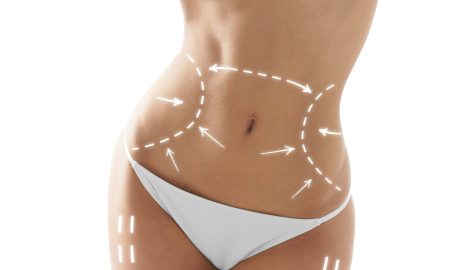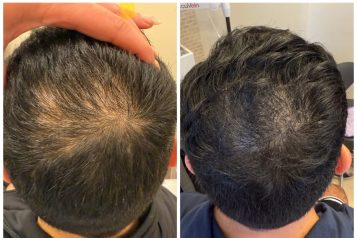 Photo Credit: Roman Samborskyi/Shutterstock
Photo Credit: Roman Samborskyi/Shutterstock
Lacey Foster, Moravarid Mehdizadeh, Samuel Lin, MD, FACS
Facial asymmetry is a natural and universal trait. Even individuals considered the epitome of beauty possess subtle imbalances in their features. Genetics establishes the foundational blueprint, determining our bone structure, muscle attachments, and the distribution of soft tissues; yet environmental factors, everyday habits, and the inevitable process of aging all compound to create the unique contours of our faces.
Even in identical twins—who share the same DNA—there may be slight disparities in facial structure due to differences in muscle tone and growth trajectories. Muscle dominance is another contributor to asymmetry: most people have a preferred chewing side, leading to one masseter muscle becoming stronger or larger and altering the jawline’s shape over time. As we age, additional asymmetries emerge (Gerth, 2015). Bone resorption, shifts in fat distribution, and changes in skin elasticity do not always happen uniformly on both sides of the face (Bartlett et al., 1992). These factors, taken together, explain why no face is perfectly symmetrical.
Day-to-day behaviors can amplify or even create new asymmetries. People often exhibit right-sided or left-sided dominance in their facial expressions, whether that means smiling more broadly on one side, raising one eyebrow more frequently, or sleeping consistently on the same side (Talisman et al., 2022). Over years, this leads to subtle differences in muscle tone, contributing to unevenness in appearance. Habitual side-sleeping, for example, can compress the skin and soft tissues, causing a slightly flatter or more hollowed look on the favored side. Similarly, chewing predominantly on one side can strengthen the jaw muscles on that side, creating a visible discrepancy in facial proportions. These tiny adjustments, repeated over a lifetime, underscore how dynamic and ever-changing the human face truly is (Kahn & Shaw, 2008).
While non-surgical treatments like Botox and fillers can enhance certain features and create better balance, the pursuit of perfect symmetry is unrealistic and can lead to overuse (Cotofana et al., 2019). Overfilling certain areas, especially the cheeks and jawline, can create an unnatural, exaggerated look that distorts facial proportions rather than enhances them. The overuse of fillers, particularly in pursuit of symmetry, can lead to facial distortion, excessive swelling, and a "puffy" or unnatural appearance (Cohen, 2008). This phenomenon, sometimes called "pillow face," results from excessive volume being placed in areas that were never meant to hold that much filler. Over time, excessive filler use can stretch the skin, making it harder to maintain natural results without requiring corrective procedures. Surgical interventions such as implants or fat grafting may offer more permanent solutions to asymmetry, but they too still come with risks, including infection, nerve damage, and dissatisfaction with the results (Rohrich & Pessa, 2018).
Rather than striving for symmetry, a more balanced and natural approach to aesthetics focuses on enhancing individual features in a way that complements each person’s unique beauty. Facial harmony is not about perfection but about proportion and structure. Strategic treatments can highlight a person’s natural contours, restore volume loss due to aging, and improve skin quality without over-altering their features. A skilled plastic surgeon or dermatologist will focus on subtle refinements rather than dramatic changes, ensuring that the results remain natural and age gracefully over time.
Ultimately, learning to embrace one’s unique features—complete with minor asymmetries—enables a healthier attitude toward cosmetic enhancement. An approach rooted in individualized care and moderation avoids the pitfalls of overcorrection, ensuring that a person’s results reflect who they are rather than an unrealistic ideal. In the end, embracing the uniqueness of our faces while making thoughtful, conservative aesthetic choices is the key to long-lasting beauty and confidence.
References:
- Bartlett SP, Grossman R, Whitaker LA. Age-related changes of the craniofacial skeleton: an anthropometric and histologic analysis. Plast Reconstr Surg. 1992 Oct;90(4):592-600.
- Cohen JL. Understanding, avoiding, and managing dermal filler complications. Dermatol Surg. 2008 Jun;34 Suppl 1:S92-9.
- Cotofana S, Lachman N. Anatomy of the Facial Fat Compartments and their Relevance in Aesthetic Surgery. J Dtsch Dermatol Ges. 2019 Apr;17(4):399-413.
- Gerth DJ. Structural and volumetric changes in the aging face. Facial Plast Surg. 2015 Feb;31(1):3-9.
- Kahn DM, Shaw RB Jr. Aging of the bony orbit: a three-dimensional computed tomographic study. Aesthet Surg J. 2008 May-Jun;28(3):258-64.
- Rohrich RJ, Pessa JE. The fat compartments of the face: anatomy and clinical implications for cosmetic surgery. Plast Reconstr Surg. 2007 Jun;119(7):2219-2227.
- Talisman R, Arnon O, Weinberger A. Facial asymmetry, the right-side dominance: A retrospective analysis of 315 consecutive series of patients. JPRAS Open. 2022 Nov 11;35:18-23. doi: 10.1016/j.jpra.2022.11.001.
For more information, visit Dr. Samuel Lin's social media:






















